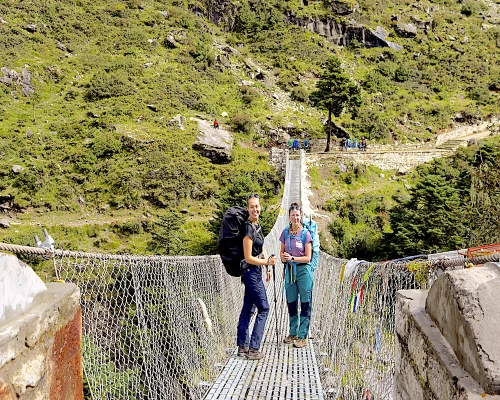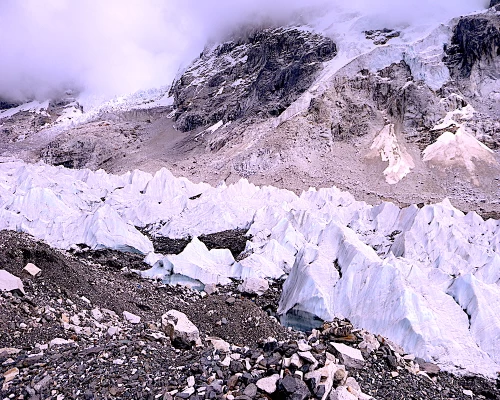Short Everest Base Camp Trek follows the same path as the Everest Base Camp Trek but takes less time to finish. Since most of the Short Everest Base Camp Treks pathways are located at altitudes greater than 3,000 meters, you must be physically fit and mentally prepared for this trekking. During a brief visit to Nepal, we at Nepal Mother House can quickly arrange access to the Mt. Everest Base Camp and the well-known vista Kalapathar.
Explore the legendary Everest base camp, the highest point on Earth, gorgeous forests, vibrant Sherpa settlements, glacier moraines, historic monasteries, and slopes.
The Everest Base Camp Short Trek is a once-in-a-lifetime experience. The Everest Base Camp Short Trek was created especially for people looking for an exhilarating adventure in the Himalayas. You have the chance to touch the base of Mount Everest, the tallest mountain in the world, during this expedition (8,848m). It is one of the most magnificent chances to go on a Himalayan journey. Tenzing Norgay Sherpa and Sir Edmund Hillary were the first to ascend it in 1953.
The Rapid Everest Base Camp Trek in Nepal gets off to a magnificent start. First, Trekkers will fly to Lukla Airfield, which is regarded as the most extreme and well-known airport in the entire globe. Next, the excursion follows the Dudhkoshi River once the trekking crew members are introduced. Before reaching Namche Bazaar for the second stage of the journey, hikers must pass through Phakding, Benkar, Manjo, and the Sagarmatha National Park Entry Gate.
No words can adequately describe Sagarmatha National Park, which is listed as a World Heritage Site. Incredible panoramic views of Mount Ama Dablam, Kangtekga, Pek 38/ Shar Tse, Lhotse Shar, Lhotse, Lhotse Col, South Col, Mount Everest, Nuptse, Tabuche Peak, and Khumbu. The trail gently ascends through the Tenzing Norgay Memorial Stupa before passing Kenjoma, descends through a pine forest to the Dhudha Kishi Bridge at Phunke Tenga, and then rises to the Tyangbuche Monastery with a stunning mountain view.
As an alternative to Tynagbuche, there is Dingboche. Before Pangbuche Village, you will cross the Imja Khola Bridge again. From there, you will head to Somare, Orsho Teahouse, Dingboche (the highest farmland in the world), Dughla/Thukla, Thukla Pass, Lobuche, Lobuche Pass, and Gorekshep (the final teahouse for the short trek to Everest Base Camp).
Near Thukla Pass, where the Khumbu Glacier starts, there are numerous memorials to the expedition's dead. You can travel from Lobuche to Gorekshep and visit the Italian Research Center (Pyramid). Mount Everest Base Camp, located at an elevation of 5,360 meters and offers breathtaking views of the Khumbu Icefall, Khumbu Glacier, and high Himalayan scenery, is the main draw of the 10-day Everest Base Camp Trek. In the spring, you can witness a lot of expedition groups. In the spring, EBC resembles a smaller version of Thamel. At the height of 5,643 meters above sea level, Kala Pathar, also known as Kalapattar (Black Rock in Nepali), is the most well-liked vantage point for the closest view of Mount Everest without the need for considerable mountaineering expertise.
Another milestone for the Short EBC Trek is this one. For the most beautiful mountain vistas, go when the sun is setting. But if you plan to stroll till twilight after sunset, you'll need to be fully equipped to prevent yourself from freezing. The view is magnificent from the top of Kalapattar. You can see Mt. Tabuche Peak, Cholatse, Lobuche East, Lobuche West, Chhumbu, Changri, Chumbu, Pumori, Lingtren , and Khumbutse .
The quickest Everest Base Camp Trek has ended at Lukla after gaining a wealth of once-in-a-lifetime experiences to return to the Sherpa Villages. Experienced local Sherpa guides and porters lead our Everest Base Camp Short Treks throughout the year. However, the optimum times to hike to Everest Base Camp in the fall and spring are from mid-September to mid-November and from mid-March to mid-May.
Outline Itinerary of Short Everest Base Camp Trek
Day 1: Fly to Lukla and Trek to Phakding(2610m)
Day 2: Trek from Phakding to Namche Bazaar(3443m/5-6 hrs)
Day 3: Trek from Namche Bazaar to Tengboche(3875m/5-6hrs)
Day 4: Trek from Tengboche to Dingboche(4410m/6-7 hrs)
Day 5: Trek from Dingboche to Lobuche(4910m/5-6hrs)
Day 6: Trek from Lobuche to Everest Base Camp(5364m) and back to Gorakshep(5140m) 7-8hrs Day
7: Trek from Gorakshep to Kalapatthar(5555m) and then to Pangboche(3900m/7-8hrs)
Day 8: Trek from Pangboche to Namche Bazaar(3443m/5-6hrs)
Day 9: Trek from Namche Bazaar to Lukla(2850m/5-6hrs)
Day 10: Fly back to Kathmandu and have Free time in Kathmandu. (1320m)
Note:- If you think of an alternate option for This Rapid trek, you might consider our Everest base camp trek return by helicopter. If you are short of holiday for ten days, you can get 5 hours Everest base camp helicopter tour. If you are here for an anniversary trip, honeymoon trip, or Engagement trip, you can choose the Luxury Lodge Everest base camp trek. Probably, this will be a tweetable alternative trip for you.
Major highlights of the Rapid or Short Everest base camp trek - 10 days
- Leaving Kathmandu, take an exhilarating flight to Lukla for the most stunning views of the landscape.
- Observe the Kalapathar, which is 5545 meters above sea level.
- Stunning vistas of the mountains, including Everest, Lhotse, Ama-Dablam, and others.
- Discover the Sherpa people's distinctive way of life and traditions
- A stroll through the most intriguing towns, green meadows, and terraced fields
- Visit the stunning and historic Tengboche monastery, which is the largest center for spiritual reunification in the entire Kumbhu Valley.
- View the Himalayas up close, including the biggest peaks Everest, Lhotse, Nuptse, Pumori, and many other nearby peaks, from the top of Kala Patthar.
- A look into the way of life of the "mountain people" who reside in the Himalayas.
Everest is one of the most famous mountains on Earth and has been at the core of mountaineering. It offers a route to the top of the world and is something every mountaineer should attempt at least once.
Everest Base Camp Trek is one of the most popular treks in Nepal. It takes you to the base camp of Mount Everest, the world's tallest mountain. The trek is doable in winter, but it requires some extra preparation. The Everest Base Camp Trek is a challenging trek that experienced hikers should only attempt. It takes you through some of Nepal's most remote and beautiful scenery. The trekking season generally runs from October to May. Some significant highlights of the Everest Base Camp trek are as follows.
The Magnificent Views of the Himalayas:- Visits to Mount Everest, the tallest mountain in the world, are a must for any Himalayan pilgrimage in Nepal. It is a massive peak in the Mahalangur region of the Himalayas, rising 29,029 feet above sea level, and its top lies on the border between Nepal and China. This trek will give you a stunning glimpse of the Himalayan Mountains under a brilliant blue sky.
Exploring Kathmandu and the Sherpa Culture: The incredible short journey offers us the chance to learn about the Sherpa people's history and enjoy hiking on the breathtaking Himalayan routes in the Everest region. Exploring the Buddhist temples and the rich cultural traditions of the Sherpas, who live in the Nepalese Himalayas, is a beautiful opportunity. The Kathmandu valley surrounding Nepal's capital is home to several historical sites, medieval temples, shrines, and intriguing villages. Meet residents and animals while admiring the monuments on Durbar Square, or join mountain hikers in the crowded Thamel.
- Experiencing Different Accommodation Options & Food on the Trek
Finding a guest house in the Everest region is relatively easy. You will have many lodging options throughout the off-season (June/July and January/February). You will have a wide range of cuisine alternatives on your trek. Meals from the menu offered by the neighborhood tea houses include Sherpa stew, fresh vegetable dishes, noodles, various soups, homemade bread dishes, rice dishes, spaghetti, pizza dishes, eggs dishes, potatoes dishes, apple pie dishes, Dal Bhat dishes, and a variety of drinks like black tea, lemon tea, hot chocolates, ginger tea, milk coffee/tea, green tea, black coffee, and lemon ginger tea.
- Entering the Sacred Khumbu Valley
The Khumbu region is one of the most sacred trails in the world, with numerous monasteries, Chortens, and hermitages for meditation.
The Khumbu region's sacred sites trail is less popular with hikers and was specifically created for individuals looking for peace to relieve tension while experiencing the spirituality of old Buddhist sacred monasteries, caves, and hermitages.
- Exploring Sagarmatha National Park
As you continue your trip, you'll enter Sagarmatha National Park, a UNESCO World Heritage Site since 1979. You will see some of the tallest mountains and rare, endangered, exotic flora and wildlife treasures.
In Nepal, Mt. Everest is known as Sagarmatha, and the Sherpa, known as Chomolungma, is of Tibetan origin. From here, walk through lovely woodland of tall rhododendrons, pine, fir, and oak trees.
- Exploring the Beauty of Namche Bazaar: A Gateway to Everest
It is a small, charming town with numerous shops, stores, banks, restaurants, hotels, and lodges. From Namche, the route to Everest base camp offers spectacular views of Everest, Lhotse, and Amadablam. Furthermore, from the highest altitude, a beautiful scenic spot Tengboche Monastery appears in your sight.
- Find Spiritual Enlightenment at Tengboche Monastery, Nepal's Oldest and Largest
The Tengboche Monastery, situated in the Khumbu region of eastern Nepal's Tengboche town, is the largest in the Everest region. It is located 3,867 meters (12,687 feet) above sea level and is a Tibetan Buddhist monastery of the Sherpa ethnic group. The Tengboche Monastery is perched on a hill, providing stunning views of Mt. Everest (8,848m), Lhotse (8,516m), the lower western peak of Ama Dablam (6,170m), Nuptse (7,861m), and Thamserku (6,608m).
- Discovering the World's Highest Base Camp and Fascinating Places
The trip to Everest Base Camp in Nepal is unquestionably the finest expedition on Earth. A long hike into a mountain valley will make you feel as though magic and miracles genuinely exist at each moment of sunrise and sunset. From the upper valley of Khumbu, the journey continues back through the verdant jungle to Lukla, where travelers will spend their final overnight in the Everest region.
Short Everest Base Camp Trek Cost 2026-2027
The price of the program includes a guide, porter service, permits, breakfast, lunch, dinner, decent teahouse lodging throughout the walk, and hotel lodging on a Trek. However, the cost of the short Everest Base Camp journey is influenced by several factors. First, it depends on the travel Company you pick because the international Company costs more than a local Nepali Company.
| NO. OF PAX | STARTING PRICE | INQURIES |
|---|---|---|
| 1-1 | 1075 | SEND INQURIES |
| 2-4 | 1000 | SEND INQURIES |
Additionally, you can choose between a basic and a luxurious standard for your excursion if to stay in a fancy hotel and use other amenities while on the hike; the cost would be much more.









